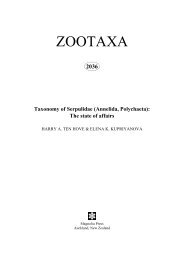Create successful ePaper yourself
Turn your PDF publications into a flip-book with our unique Google optimized e-Paper software.
16. Desmoncus osensis Henderson, sp. nov. (Appendix IV Plates 20–21)<br />
A Desmonco obovoideo pinnis basalibus longioribus atque angustioribus diifert.<br />
Type:—COSTA RICA. Puntarenas: Golfito, Distrito Golfito, Refugio de Vida Silvestre Golfito, camino a La Gamba,<br />
8°40’N 83°11’W, 94 m, 9 October 2008, R. Aguilar 11417 (holotype NY!, isotypes CR n.v., USJ n.v.).<br />
Plants height no data; stems 1.6(1.2–2.6) cm diameter, branching no data. Leaf petioles 2.7(2.0–3.5) cm long;<br />
rachises 85 cm long, 7.1(6.4–7.8) mm wide, the spines usually >1 cm long, mostly adaxial or lateral, straight<br />
with briefly swollen bases; pinnae 13 per side of rachis, without long, filiform apices, with an adaxial beard of<br />
spines at the bases, without spinules or dense tomentum at the bases adaxially; basal pinna 23.2(18.0–26.0)<br />
cm long, 3.7(2.4–5.0) cm wide; cirri well-developed, with acanthophylls, without spines abaxially, with<br />
intermediate acanthophylls present, without a wide gap between pinnae and acanthophylls. Inflorescences<br />
with the rachis ridged, not twisted, much thicker than the numerous, closely spaced and spirally or irregularly<br />
arranged rachillae, each rachilla not or only briefly adnate to the rachis, subtended by an acute bracteole and<br />
with a well-developed axillary pulvinus; peduncles 4.5(4.1–4.8) mm wide; peduncular bracts length no data,<br />
broad, the surfaces ribbed, brown tomentose, sparsely to densely covered with long, straight or sinuous,<br />
briefly swollen-based, diagonally or vertically oriented spines, these flattened or triangular in cross-section,<br />
whitish-brown proximally, black or brown distally, with tomentose margins (rarely without spines); rachillae<br />
19(18–19), glabrous or scarcely tomentose initially; proximal rachillae length no data, 1.6 mm wide; stamens<br />
9; fruits 15.1(13.9–17.3) mm long, 13.6(11.0–15.9) mm wide, the surfaces uneven with numerous,<br />
subepidermal, long, branching fibers; fruiting corollas less than one quarter as long as fruits, splitting<br />
irregularly into 3 lobes, the lobes often splitting again; endocarps broadly obovoid with flattened apices, the<br />
pores lateral on or near flattened apices.<br />
Distribution and habitat:—From 8°36’–9°31’N and 83°11’–84°06’W in the Osa Peninsula and adjacent<br />
areas in Costa Rica at 145(50–350) m elevation in lowland rainforest (Fig. 10).<br />
Taxonomic notes:—Desmoncus osensis is similar to D. obovoideus and shares all character states except<br />
that D. obovoideus lacks data for stamen number. Desmoncus osensis also has longer and narrower basal<br />
pinna compared to D. obovoideus (mean of 23.2 cm long and 3.7 cm wide versus 14.0 cm long and 4.9 cm<br />
wide). Based on this, and geographic separation, the two are recognized as separate species.<br />
Subspecific variation:—Hammel et al. (2003) had only two specimens (Aguilar 290, Morales 6333)<br />
available from the Osa Peninsula, and identified them as Desmoncus sp. A. They considered that these two<br />
specimens were different from one another and possibly not conspecific. In the present study, seven<br />
specimens have been examined. They are indeed variable, and in some the adaxial beard of spines at the bases<br />
of the pinnae are poorly-developed. Some of this variation may be due to the age of the leaves represented by<br />
the specimens. There is also variation in fruit size. Without more specimens it is not possible to resolve this<br />
problem.<br />
18. Desmoncus parvulus Bailey (1948: 115).<br />
Type:—GUYANA. Potaro–Siparuni: Tumatumari, 18 June–8 July 1921, H. Gleason 164 (holotype NY! isotype US!).<br />
Desmoncus kaieteurensis Bailey (1948: 115). Type:—GUYANA. Potaro-Siparuni: trail from Tukeit to Kaiatuk Plateau,<br />
29 April 1944, B. Maguire & D. Fanshawe 23093 (holotype BH!, isotypes K!, NY!).<br />
Plants 4.4(1.5–10.0) m tall; stems 0.8(0.4–1.8) cm diameter, clustered. Leaf petioles 6.0(0.7–13.8) cm long;<br />
rachises 31.7(22.5–47.0) cm long, 2.7(1.7–3.8) mm wide, the spines usually
















